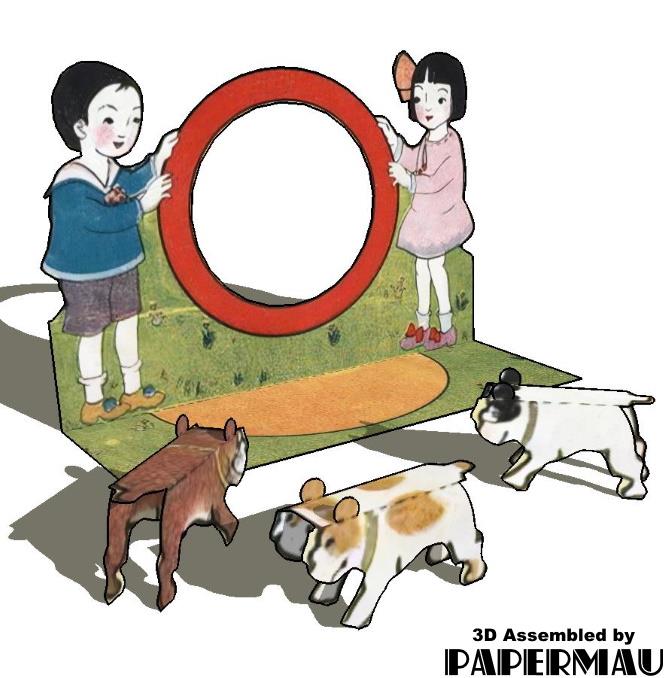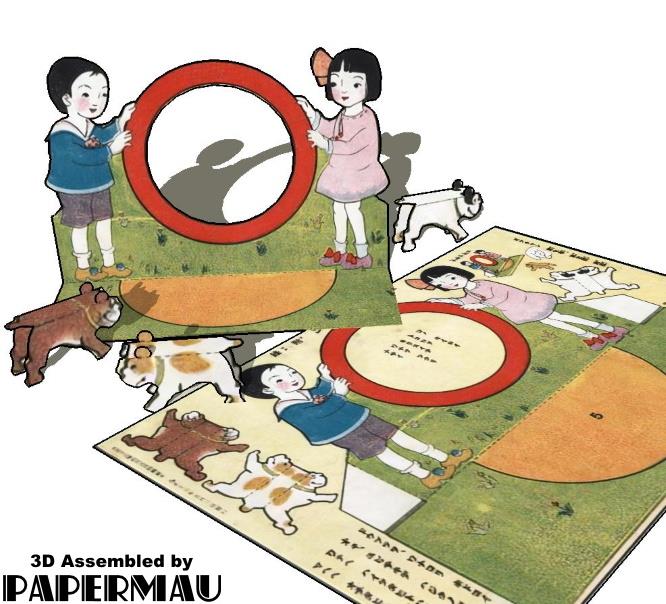This beautiful vintage papercraft of a Malay house on stilts was originally published in the now defunct variety magazine Illustreret Familie-Journals, probably between the end of the 19th century and the beginning of the 20th century.
I would like to thank collector Esben Rasmussen for preserving and kindly sharing this model.
In the original text (in Danish) that accompanies the model, one can read: - "When the Malays build their huts on stilts, it is not enough to build a hut that is healthy and spacious to live in, - it must also meet all the requirements of the which the Malays consider to be in good taste, because otherwise the other villagers might demolish it immediately.
From the pieces on the next two pages, the reader will be able to put together a beautiful paper model, which will be an exact copy of a beautiful Malay hut , as a Malay would build it for himself and his family, as well as for his cattle.
The house is built on stilts, so that moisture from the marshy soil does not penetrate the building. Domestic animals are sheltered between the stilts and the family accesses the house via stairs, which avoid unwanted guests, such as wild animals.
The huts are decorated with beautiful ornaments done in bright colors and, as they are covered and sealed with palm fibers, they are pleasantly cool in summer and maintain comfortable temperatures in the rainy season."
"Illustreret Familie-Journals" was a popular Danish periodical founded in 1862. It was a weekly magazine that covered a variety of topics, including literature, culture, news, fashion, and entertainment.
The magazine's highlight was the inclusion of illustrations and images, making it appealing to a broad audience. It was one of the most influential and popular publications in Denmark during the late 19th and early 20th centuries.
The magazine enjoyed great success over the years and played a significant role in spreading culture and knowledge in Denmark during the late 19th and early 20th centuries.
It was known for its wide range of content and its contribution to the education and entertainment of Danish readers. The magazine covered a wide range of topics, from literature and science to fashion, cooking, and entertainment, making it an attractive read for people of all ages and interests.
"Illustreret Familie-Journals" played a fundamental role in promoting education and culture in Denmark.
Through its informative and literary articles, the magazine contributed to the dissemination of knowledge among the population. The magazine also served as a platform for discussing social and political issues of the time. It played a role in shaping public opinion and raising awareness of relevant issues.
The magazine maintained its popularity for decades, being published weekly until 1974 when it ceased production after more than a century of existence.
Of particular interest, papercrafts were a distinctive feature of "Illustreret Familie-Journals" editions.
This Danish magazine often included supplements with papercrafts that readers could cut out, assemble, and collect. These papercrafts were typically colorful illustrations of characters, scenes, or objects related to the topics covered in the magazine.
The inclusion of papercrafts was a clever strategy to engage readers of all ages and make the magazine more interactive. It allowed children to get involved in craft activities by cutting and assembling the figures, while adults also appreciated the high-quality illustrations.
The papercrafts in "Illustreret Familie-Journals" spanned a variety of themes, from fairy tale scenes and architectural models to historical figures and vehicles.
They not only added value to the magazine but also encouraged sharing and interaction among readers, who often exchanged papercrafts to complete their collections.
Over time, these papercrafts became collectible items and are remembered as an iconic part of "Illustreret Familie-Journals," contributing to its long and influential history in Danish culture.
Este belíssimo e antigo papercraft de uma casa sobre palafitas Malaia foi originalmente publicada na extinta revista de variedades Illustreret Familie-Journals, provavelmente entre o final do século XIX e início do século XX.
Deixo aqui meus agradecimentos ao colecionador Esben Rasmussen, por preservar e gentilmente compartilhar este modelo.
No texto original (em dinamarquês) que acompanha o modelo, pode-se ler: - "Quando os malaios constroem as suas cabanas de palafitas, não basta construir uma cabana que seja saudável e espaçosa para viver, - também deve cumprir todos os requisitos do que os malaios consideram de bom gosto, porque senão os outros moradores da aldeia podem demolí-la imediatamente.
A partir das peças das próximas duas páginas, o leitor poderá montar um belo modelo de papel, que será uma cópia exata de uma bela cabana malaia, como um malaio a construiria para si e sua família, bem como para seu gado.
A casa é construída sobre palafitas, para que a umidade do solo pantanoso não penetre na construção. Os animais domésticos são abrigados entre as palafitas e a família acessa a casa por escadas, que evitam convidados indesejados, como animais selvagens.
As cabanas são decoradas com belos ornamentos feitos em cores vivas e, como são cobertas e seladas com fibras de palmeira, são agradavelmente frescas no verão e mantém temperaturas confortáveis na estação chuvosa."
"Illustreret Familie-Journals" era um popular periódico dinamarquês fundado em 1862. Era uma revista semanal que abordava uma variedade de tópicos, incluindo literatura, cultura, notícias, moda e entretenimento.
O destaque da revista era a inclusão de ilustrações e imagens, tornando-a atrativa para um amplo público. Foi uma das publicações mais influentes e populares na Dinamarca durante o final do século XIX e início do século XX.
A revista desfrutou de grande sucesso ao longo dos anos e desempenhou um papel significativo na disseminação da cultura e do conhecimento na Dinamarca durante o final do século XIX e início do século XX.
Ela era conhecida por sua ampla variedade de conteúdo e por sua contribuição para a educação e entretenimento do público leitor dinamarquês. A revista abordava uma ampla gama de tópicos, desde literatura e ciência até moda, culinária e entretenimento. Isso a tornava uma leitura atraente para pessoas de todas as idades e interesses.
O "Illustreret Familie-Journals" desempenhou um papel fundamental na promoção da educação e cultura na Dinamarca. Através de seus artigos informativos e literários, a revista contribuiu para a disseminação do conhecimento entre a população.
A revista também serviu como uma plataforma para discutir questões sociais e políticas da época. Ela desempenhou um papel na formação da opinião pública e na conscientização sobre questões relevantes.
Ela manteve sua popularidade por décadas, sendo publicada semanalmente até 1974, quando cessou sua produção após mais de um século de existência.
O que mais nos importa aqui, os papercrafts eram uma característica marcante das edições do "Illustreret Familie-Journals". Ela frequentemente incluía suplementos com papercrafts que os leitores poderiam recortar, montar e colecionar.
Esses recortáveis eram geralmente ilustrações coloridas de personagens, cenários ou objetos que se relacionavam com os tópicos abordados na revista. A inclusão de papercrafts era uma estratégia inteligente para cativar leitores de todas as idades e tornar a revista mais interativa. Isso permitia que as crianças se envolvessem em atividades de artesanato, recortando e montando as figuras, enquanto os adultos também apreciavam as ilustrações de alta qualidade.
Os recortáveis do "Illustreret Familie-Journals" abrangiam uma variedade de temas, desde cenas de contos de fadas, modelos arquitetônicos, até figuras históricas e veículos.
Eles não só adicionavam valor à revista, mas também incentivavam o compartilhamento e a interação entre os leitores, que muitas vezes trocavam recortáveis entre si para completar suas coleções.
Esses recortáveis se tornaram itens colecionáveis ao longo do tempo e são lembrados como uma parte icônica do "Illustreret Familie-Journals", contribuindo para a longa e influente história da revista na cultura dinamarquesa.




























